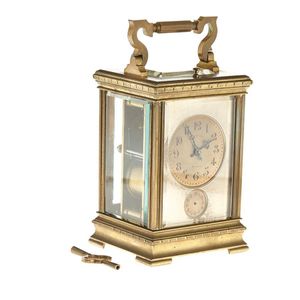19th Century Brass Striking Carriage Clock
You must be a subscriber, and be logged in to view price and dealer details.
Subscribe Now to view actual auction price for this item
When you subscribe, you have the option of setting the currency in which to display prices to $Au, $US, $NZ or Stg.
- Laurel Leaf - The use of the laurel leaf as a decorative element can be traced back to ancient Greece and Rome, where it was closely associated with victory and honour. In these cultures, the laurel was a sacred tree that was dedicated to the god Apollo and was believed to have protective and healing properties.
In ancient Greece, the laurel wreath was awarded to victors in athletic competitions, such as the Olympic Games, as a symbol of their achievement. The wreath was also associated with academic achievement, and was often worn by scholars and poets. The Greeks also used the laurel leaf as a symbol of victory in war, and it was often depicted in artwork alongside images of triumphant warriors and heroes.
The Romans continued this tradition, and the laurel wreath became a symbol of the highest military honor, the triumph, awarded to victorious generals. The wreath was also used to crown emperors and other important officials, and was often depicted in Roman art and architecture as a symbol of power and authority.
The laurel leaf is still used as a symbol of achievement, success, and excellence, and is frequently used in logos, emblems, and other branding materials. Its association with victory and honour has made it a popular choice for awards, medals, and other forms of recognition. - Foliate - Decorated with leaves or leaf-like forms.
- Movement - The technical name for the workings of a clock or watch, and does not include the dial or case.
- Filigree Work - Decorative Arts - Delicate decorations using fine threads of ceramics, glass or other materials to give a lace-like effect, attached together and applied as an ornament.
This item has been included into following indexes:
- clocks, carriage
Visually similar items

A good large French 19th century Repeat, alarm, striking carriage clock, c.1870, in heavy gilded brass case with recessed square corner pillars and concave moulded borders on bracket feet. Silvered dial mask with cutout face, Arabic numerals and subsidiary

Kienzle Radium gong timber wall clock with columned support & a pendulum. Condition fair to poor, needs restoration. Length 104 cm

A good French 19th century carriage clock, c.1870, the case with reeded corner columns and frieze borders of relief grape vines. Satin gold dial mask with silvered chapter ring and Arabic numerals. Timepiece movement with lever platform. Stamped R & Co Par

A George III black lacquer longcase clock By J. Davis, Lemon Street, the 8-day bell strike movement with anchor escapement and rack strike, seconds dial, silent strike dial in the break arch and date aperture at 6, silvered dial and gilt spandrels, the cas
